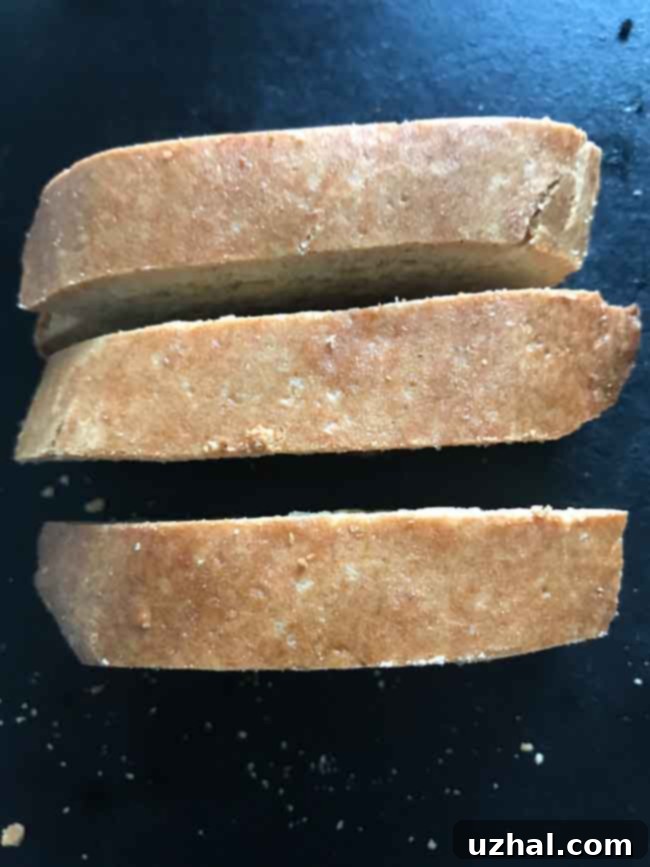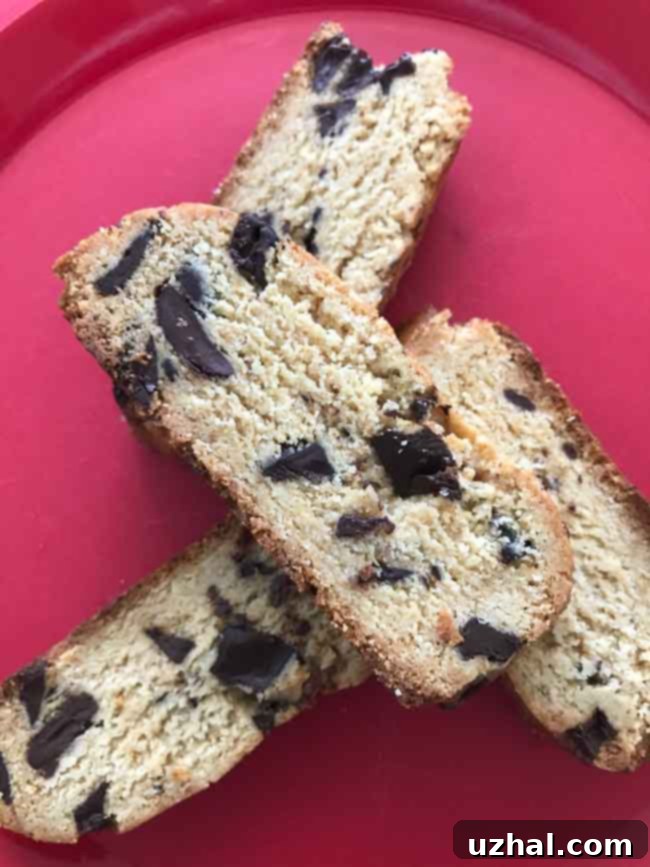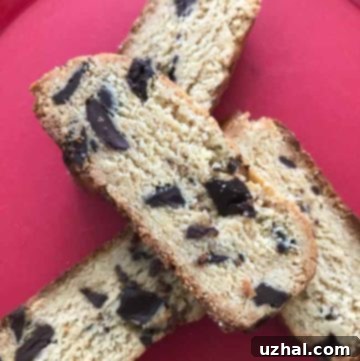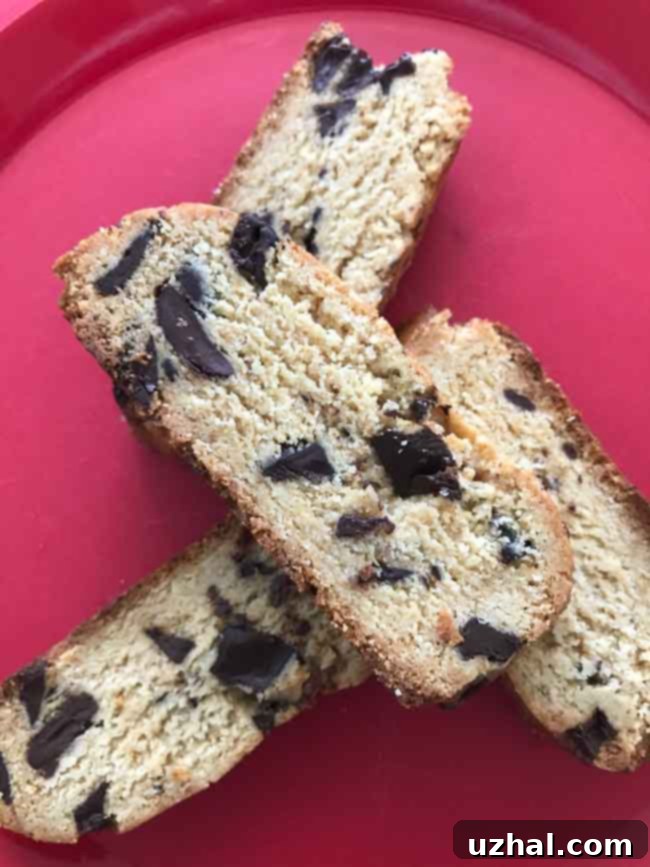Deliciously Grain-Free: Maple Almond Flour Biscotti with Arrowroot for a Healthier Treat
For those who adore the crisp, satisfying crunch of biscotti but seek a healthier alternative, this recipe for grain-free and gluten-free maple almond flour biscotti is an absolute game-changer. My recent enjoyment of traditional biscotti sparked a desire to create a version that aligns with a more health-conscious approach, without sacrificing any of the delightful flavors or textures. This quest led me to explore the incredible potential of almond flour and arrowroot, two foundational ingredients in the world of gluten-free and grain-free baking.
The internet is brimming with innovative recipes utilizing these ingredients, and I meticulously tested and refined elements from two particularly inspiring sources: one from Camilla at Power Hungry and another from Molly at What Molly Ate. Both provided exceptional insights into crafting a perfect grain-free biscotti, making it challenging to pick a single favorite. Ultimately, I embarked on a culinary fusion, carefully combining the most successful aspects of both recipes to develop what I believe is the ultimate healthier biscotti. The exquisite result is an almond flour, arrowroot, and maple syrup biscotti that boasts a uniquely smooth, fine texture and a rich, satisfying flavor profile. An added benefit to this delightful treat is its relatively short and straightforward ingredient list, making it approachable for bakers of all skill levels.

Understanding Arrowroot in Grain-Free Baking
Arrowroot, a remarkable starch, originates from the underground stems, or rhizomes, of various tropical plants, most notably Maranta arundinacea. Unlike grains, arrowroot is derived from a tuber, making it an excellent choice for individuals adhering to a grain-free diet. One of its highly valued attributes is its exceptional digestibility, a characteristic that has historically made it a popular ingredient in gentle foods like teething biscuits for babies. For many years, my primary association with arrowroot was limited to these delicate infant cookies. However, as my culinary knowledge expanded, I discovered its much broader and more significant role as a powerful thickening agent in the kitchen.
In contemporary baking, particularly within the gluten-free community, arrowroot has become an indispensable component. It is readily available in most grocery stores and online, making it an accessible ingredient for home bakers. In gluten-free recipes, arrowroot powder acts as a fantastic binder and thickener, helping to create structure and a desirable texture that might otherwise be missing in the absence of gluten. For biscotti, in particular, arrowroot contributes to the desired crispness and helps achieve that smooth, fine crumb that is so appealing. It also aids in preventing the dough from becoming too crumbly, which can be a common challenge when working with nut flours like almond flour. Its neutral flavor ensures it doesn’t overpower the other delightful tastes in your biscotti, allowing the maple and almond notes to shine. Beyond its functional benefits, arrowroot is also a source of several B vitamins and minerals, adding a subtle nutritional boost to your baked goods.
Achieving the Perfect Texture: The Role of Almond Flour, Arrowroot, and Sweeteners
One of the most distinguishing features of this almond flour biscotti is its remarkably smooth crust and delicate internal structure. This exquisite texture is not coincidental; it’s a direct result of the thoughtful selection of ingredients and their interplay during the baking process. I believe the arrowroot flour plays a crucial role here, contributing to the fine, almost powdery feel of the crust and preventing a coarse or grainy finish. Additionally, the choice of sweetener significantly impacts the final texture.

When I prepared the biscotti with a full ⅓ cup of pure maple syrup, the crust developed an exceptionally smooth and unblemished surface. Maple syrup, being a liquid sweetener, integrates seamlessly into the dough, providing moisture and contributing to a consistent, even bake. This results in a biscotti that not only looks elegant but also offers a satisfyingly uniform bite. Maple syrup’s hygroscopic properties mean it attracts and retains moisture, contributing to a slightly softer interior before the second bake, and a beautifully even browning. In contrast, when I experimented with a mixture of ¼ cup maple syrup and 2 tablespoons of coconut sugar, the crust showed a few minor cracks. Coconut sugar, while a great natural sweetener with a caramel-like flavor, is a granular ingredient. Its crystalline structure can slightly disrupt the dough’s continuity, leading to subtle imperfections in the crust as the biscotti bakes and expands. However, these cracks are purely aesthetic and do not detract from the deliciousness.
Beyond the crust, these sweeteners also influence the overall height and internal crumb of the biscotti. The advantage of using the maple syrup/coconut sugar combination is that the cookies tend to bake up a little taller. Coconut sugar, with its different sugar profile and crystal size, can sometimes provide a bit more lift or structure to baked goods, contributing to a slightly airier, taller profile. This slight increase in height can be desirable for a more substantial-looking biscotti. Therefore, your choice between using all maple syrup or a combination will depend on your preference for crust smoothness versus a slightly taller biscotti, as well as the ingredients you have readily available in your pantry. Both variations yield a delicious outcome, allowing for flexibility in your baking journey. Regardless of the sweetener choice, the inherent properties of almond flour—its fine grind, high protein content, and healthy fats—ensure a tender, rich crumb that is deeply satisfying and distinct from traditional wheat-based biscotti. Blanched almond flour, in particular, offers a lighter color and finer texture compared to unblanched varieties, further enhancing the delicate nature of these biscotti.

Elevating the Flavor: The Irresistible Addition of Chocolate Chunks
Initially, I was so enamored with the inherent deliciousness of the plain maple almond flour biscotti that I questioned the necessity of adding anything else. Its delicate sweetness and rich almond flavor seemed perfectly complete on their own. However, my curiosity eventually led me to experiment with adding chocolate chunks, and the result was undeniably superior. The addition of chocolate transformed an already excellent biscotti into an extraordinary one, creating a harmonious balance between the nutty sweetness of the biscotti base and the deep, complex notes of dark chocolate. For this reason, I wholeheartedly recommend the chocolate-infused version, as it adds another layer of indulgence that is truly delightful.
When choosing chocolate, the quality truly makes a difference. I opted for chopped dark chocolate, specifically Dove Dark, which melts beautifully and offers a luxurious, slightly bitter contrast to the sweet biscotti. Dark chocolate (70% cocoa or higher) also brings antioxidant benefits. You can experiment with different types of chocolate, such as semi-sweet chips, milk chocolate, or even white chocolate, to suit your personal taste. Consider using chocolate chunks rather than chips, as chunks tend to distribute more evenly and provide a more substantial bite of chocolate in each slice. Beyond chocolate, this recipe is incredibly adaptable to other additions. Consider incorporating a handful of toasted nuts like pistachios, pecans, or walnuts for added crunch and depth of flavor, or a sprinkle of warming spices such as cinnamon, cardamom, or even a hint of nutmeg. A touch of orange or lemon zest could also brighten the flavor profile, offering a refreshing citrusy note that pairs wonderfully with both almond and chocolate. Dried cranberries or cherries would add a tart chewiness, creating an even more complex treat. The beauty of this recipe lies in its versatility, allowing you to customize it to your heart’s content and create your own signature grain-free biscotti for any occasion.
Mastering the Art of Biscotti: Tips for the Perfect Twice-Baked Treat
Biscotti, Italian for “twice-baked,” owes its characteristic crispness and durability to its unique preparation method. The dough is first baked in a log shape, then sliced and baked a second time until dry and firm. This two-step baking process is crucial for achieving the classic texture that makes biscotti perfect for dipping into coffee, tea, or even a glass of dessert wine. To ensure your maple almond flour biscotti turn out perfectly, here are some essential tips:
Shaping the Dough: When forming the dough into logs, aim for a consistent width and height. The recipe suggests two smaller logs (each about 4 inches long, 2 ½ inches wide, and a little less than an inch tall) which not only yields more desirable “edge pieces” but also allows for testing a smaller batch if you halve the recipe. If you prefer, a single 8-inch log can be made, but ensure it’s evenly shaped to promote uniform baking. Don’t worry too much about perfection at this stage; slight irregularities add to the rustic charm of homemade biscotti.
The First Bake: The initial bake sets the shape and begins to cook the dough. The biscotti logs should be golden brown, indicating they are cooked through but not yet crisp. This first bake doesn’t fully crisp them; its primary purpose is to solidify the structure so they can be sliced cleanly. Over-baking at this stage can lead to dry, crumbly slices later, so keep a watchful eye on the color and consistency.
Chilling is Key: After the first bake, it’s absolutely essential to allow the logs to cool completely to room temperature, and then chill them in the refrigerator for several hours or, ideally, overnight. This chilling period firms up the dough significantly, making it much easier to slice without crumbling. Cold dough yields clean, precise cuts, which are crucial for beautifully shaped biscotti. Trying to slice warm logs will likely result in uneven, broken pieces, diminishing the aesthetic appeal and structural integrity of your biscotti.
The Second Bake: Once chilled and sliced into 1-inch (or slightly thinner) pieces, arrange the biscotti on a baking sheet, standing them upright if possible. This allows for even drying and crisping on all sides. If your slices are too thin to stand, simply lay them on their sides and flip them halfway through the second bake to ensure both sides get adequately toasted. The goal of this second bake, performed at a lower temperature (250°F), is to remove excess moisture, resulting in that signature snap and crunch. Bake until they are completely dry and crisp throughout, achieving that satisfying texture biscotti is famous for.
Cooling and Storage: After the second bake, let the biscotti cool completely on the baking sheet. They will continue to crisp up as they cool, transforming from warm, slightly pliable cookies into perfectly crunchy delights. Once fully cooled, store them in an airtight container at room temperature for up to two weeks. Their sturdy nature makes them excellent for gifting or preparing ahead of time. The longer they sit, the crispier they become, making them even better for dipping into your favorite hot beverage.
The Healthier Indulgence: Benefits of Grain-Free and Gluten-Free Baking
Embracing grain-free and gluten-free baking, especially with ingredients like almond flour and arrowroot, offers a myriad of benefits that extend beyond catering to specific dietary restrictions. For those with celiac disease or gluten sensitivity, these biscotti provide a safe and delicious treat. However, the advantages are not limited to this group.
Almond flour, the primary base for these biscotti, is a nutritional powerhouse. It’s naturally rich in healthy monounsaturated fats, which are beneficial for heart health. It also boasts a significantly higher protein content compared to traditional wheat flour, contributing to a feeling of fullness and sustained energy. Furthermore, almond flour is an excellent source of dietary fiber, vitamin E (a powerful antioxidant), and minerals like magnesium and manganese. Its low carbohydrate profile also makes these biscotti a more blood-sugar-friendly option compared to many conventional cookies, appealing to those managing sugar intake or following ketogenic principles.
Arrowroot, as discussed, is highly digestible and gentle on the stomach. It’s a clean starch that won’t cause digestive distress for most individuals, unlike some grain-based alternatives. By choosing these grain-free ingredients, you are not only making a dietary choice but also often opting for ingredients that are less processed and more nutrient-dense. This approach allows for guilt-free indulgence, transforming a classic treat into a wholesome snack that supports your well-being with every delightful crunch. Enjoying these maple almond flour biscotti means savoring a delicious dessert that supports your health-conscious lifestyle with every delightful bite.
- Double Chocolate Biscotti Recipe
- Banana Biscotti
- Small Batch Butterscotch Whole Wheat
- Small Batch Cinnamon Butterscotch
- Double Chocolate Thin Biscotti
Recipe

Maple Almond Flour Biscotti
Pin Recipe
Ingredients
- 2 cups blanched almond flour (200 grams)
- ¼ cup arrowroot flour
- 1 teaspoon baking powder
- ½ teaspoon salt
- 2 tablespoons unsalted butter softened (28 grams)
- ⅓ cup maple syrup OR use ¼ cup maple syrup and 2 T. coconut sugar
- 1 teaspoon vanilla
- ½ teaspoon almond extract optional
- ½ cup chopped dark chocolate I used Dove Dark
- Egg wash 1 beaten egg mixed with a little water (you’ll have leftover egg wash)
Instructions
-
Preheat oven to 350°F. Line a baking sheet with parchment paper.
-
Mix the almond flour, arrowroot, baking powder and salt together in a large bowl. Add the softened butter and stir until butter is evenly blended.
-
Add the maple syrup and extracts, then stir everything together to make a soft dough.
-
Divide dough in half and shape each half into two logs, each about 4 inches long, 2 ½ inches wide and a little less than an inch tall. If you prefer you can make one log that is 8 inches long, but two small logs gives you more edge pieces.
-
Bake for 28 minutes. Biscotti should be golden brown. Let cool to room temperature, then put in the refrigerator and chill for several hours or overnight.
-
Heat the oven to 250.
-
Cut the cold biscotti into 1 inch (or make slightly thinner if desired) slices.
-
Stand biscotti on a baking sheet and bake for about 35 minutes at 250. If for some reason your biscotti slices won’t stand (say, you cut them super thin!), you can lay them on their sides and flip.
-
Let the biscotti cool completely. It will crisp as it cools.
Notes
